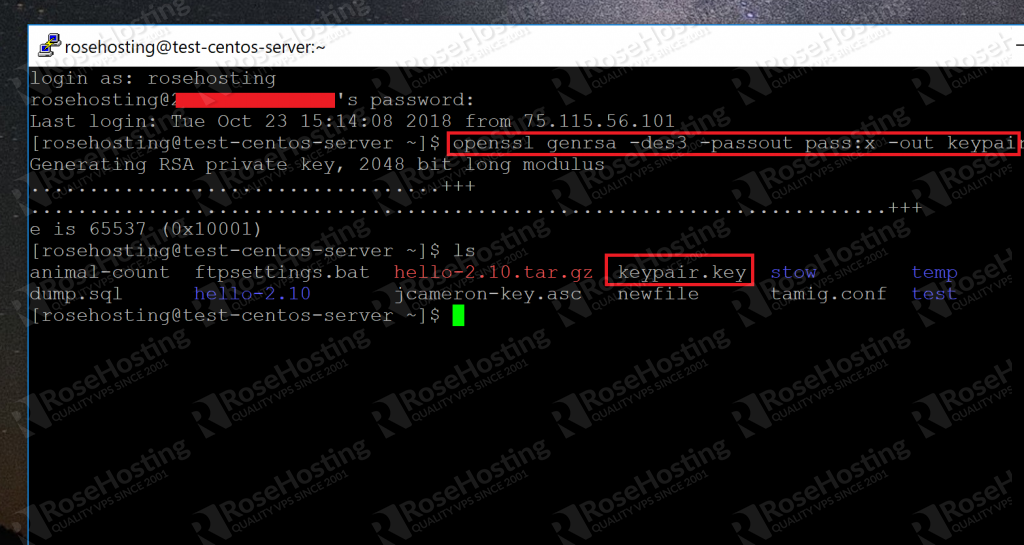Generate Key From Crt Openssl
The following instructions will guide you through the CSR generation process on Nginx (OpenSSL). To learn more about CSRs and the importance of your private key, reference our Overview of Certificate Signing Request article. If you already generated the CSR and received your trusted SSL certificate, reference our SSL Installation Instructions and disregard the steps below.
- Openssl Generate Crt And Key From Pem
- Generate Key From Crt Openssl Error
- Generate Key From Crt Openssl Download
- Openssl Generate Private Key
- Openssl Generate Crt And Key From Pfx
The certificate is made out of your public key. The public and private keys are completely separate (by definition) and you can't generate one from the other. How was this new.crt file generated? There just has to be a key file and a CSR somewhere! – Alexios Jan 7 '14 at 10:00. $ openssl req -new -key /path/to/wwwservercom.key -out /path/to/wwwservercom.csr. This will fire up OpenSSL, instruct it to generate a certificate signing request, and let it know to use a key we are going to specify – the one we just created, in fact.
1. Log in to your server’s terminal.
You will want to log in via Secure Shell (SSH).
2. Enter CSR and Private Key command
Generate a private key and CSR by running the following command: Aes 32 byte key generator.

Openssl Generate Crt And Key From Pem
Here is the plain text version to copy and paste into your terminal:
Note:Replace “server ” with the domain name you intend to secure.
Generate Key From Crt Openssl Error
3. Enter your CSR details
Enter the following CSR details when prompted:
- Common Name: The FQDN (fully-qualified domain name) you want to secure with the certificate such as www.google.com, secure.website.org, *.domain.net, etc.
- Organization: The full legal name of your organization including the corporate identifier.
- Organization Unit (OU): Your department such as ‘Information Technology’ or ‘Website Security.’
- City or Locality: The locality or city where your organization is legally incorporated. Do not abbreviate.
- State or Province: The state or province where your organization is legally incorporated. Do not abbreviate.
- Country: The official two-letter country code (i.e. US, CH) where your organization is legally incorporated.
Note: You are not required to enter a password or passphrase. This optional field is for applying additional security to your key pair.
4. Generate the order
Locate and open the newly created CSR in a text editor such as Notepad and copy all the text including:
Note 1: Your CSR should be saved in the same user directory that you SSH into unless otherwise specified by you.
Note 2: We recommend saving or backing up your newly generate “.key ” file as this will be required later during the installation process.
Return to the Generation Form on our website and paste the entire CSR into the blank text box and continue with completing the generation process.
Upon generating your CSR, your order will enter the validation process with the issuing Certificate Authority (CA) and require the certificate requester to complete some form of validation depending on the certificate purchased. For information regarding the different levels of the validation process and how to satisfy the industry requirements, reference our validation articles.
After you complete the validation process and receive the trusted SSL Certificate from the issuing Certificate Authority (CA), proceed with the next step using our SSL Installation Instructions for Nginx using OpenSSL.
Was this article helpful?
Related Articles
Windows xp sp2 product key generator. You have a private key file in an openssl format and have received your SSL certificate. You'd like now to create a PKCS12 (or .pfx) to import your certificate in an other software?
Here is the procedure!
- Find the private key file (xxx.key) (previously generated along with the CSR).
- Download the .p7b file on your certificate status page ('See the certificate' button then 'See the format in PKCS7 format' and click the link next to the diskette).
- a) Convert this file into a text one (PEM):
On Windows, the OpenSSL command must contain the complete path, for example:
c:openssl-win32binopenssl.exe ..) - b) Now create the pkcs12 file that will contain your private key and the certification chain:
You will be asked to define an encryption password for the archive (it is mandatory to be able to import the file in IIS). You may also be asked for the private key password if there is one!
You can now use the file file final_result.p12 in any software that accepts pkcs12! For IIS, rename the file in .pfx, it will be easier.
Alternatively, if you want to generate a PKCS12 from a certificate file (cer/pem), a certificate chain (generally pem or txt), and your private key, you need to use the following command: